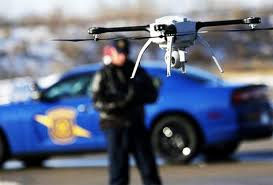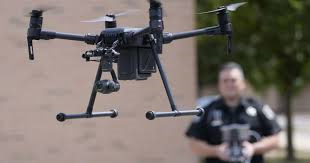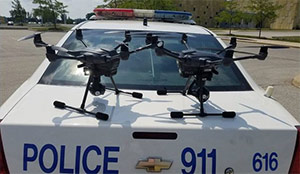Contact Us
To provide feedback on the Community Policing Dispatch, e-mail the editorial board at CPDispatch@usdoj.gov.
To obtain details on COPS Office programs, publications, and resources, contact the COPS Office Response Center at 800-421-6770 or AskCopsRC@usdoj.gov

U.S. Department of Justice
Office of Community Oriented Policing Services
Washington, DC 20530
 I recently participated in an important forum on the uses of Unmanned Aircraft Systems (UAS), also known as drones, in law enforcement. This ground-breaking meeting brought over 200 federal, state, and local law enforcement leaders together to share experiences, discuss challenges, and consider strategies for the way forward with this rapidly growing technology. Principal Deputy Associate Attorney General Jesse Panuccio addressed the meeting, which was hosted by the COPS Office in partnership with the Police Executive Research Forum and the Department of Homeland Security’s Office of State and Local Law Enforcement.
I recently participated in an important forum on the uses of Unmanned Aircraft Systems (UAS), also known as drones, in law enforcement. This ground-breaking meeting brought over 200 federal, state, and local law enforcement leaders together to share experiences, discuss challenges, and consider strategies for the way forward with this rapidly growing technology. Principal Deputy Associate Attorney General Jesse Panuccio addressed the meeting, which was hosted by the COPS Office in partnership with the Police Executive Research Forum and the Department of Homeland Security’s Office of State and Local Law Enforcement.
Featured Podcasts
Drones Podcast Series
This special series takes an in-depth look at considerations for police departments looking to implement an Unmanned Aerial Systems (UAS) program, and features officers who are responsible for Drone operations from the Chula Vista Police Department (CA), Michigan State Police, and the Torrance Police Department (CA).
According to a recent Federal Aviation Administration (FAA) estimate, more than one million recreational and commercial drones are now used in the US, and within the next three years that number is likely to increase to as many as 2.4 million. Law enforcement use has become widespread too. In 2017, it was estimated that about 347 police departments, sheriffs’ offices, and EMS and fire departments in 43 states were flying drones. And it is expected that this number will grow dramatically—for good reason.
Drones can be a game changer for law enforcement in many areas, such as accident reconstruction, search and rescue, fugitive apprehension, border control surveillance, and crowd and crime scene monitoring. Less expensive than helicopters, their size also makes them better adapted to tasks such as surveilling alleyways or building interiors.
 UAS technology is an invaluable tool for saving lives – those of law enforcement as well as the public. In addition to their ability to shave hours, even days, off searches for missing children, adults and individuals with disabilities, drones can vastly improve a responding officer’s situational awareness.
UAS technology is an invaluable tool for saving lives – those of law enforcement as well as the public. In addition to their ability to shave hours, even days, off searches for missing children, adults and individuals with disabilities, drones can vastly improve a responding officer’s situational awareness.
Used as first responders, drones can scout the scene prior to the officers’ arrival, feeding live video to commanders and field supervisors who can provide tactical advice to those on the ground. And with powerful cameras attached, drones can sometimes let an officer determine what a suspect has in his or her hands, whether it’s a camera or a gun, avoiding unnecessary uses of force. In some situations, these aerial scouts can even allow dispatchers to prioritize calls for service.
But despite their many benefits, some members of the public are wary about UAS use in law enforcement, especially the potential for privacy invasion. Some may fear that drones will spy on them. To allay those concerns, and also decrease a department’s legal liabilities, forum speakers emphasized the need for transparency and discussed various approaches for building public trust, including holding public hearings and using social media to explain how the drones will be deployed.
Another major area of concern is how to respond to the misuse of drones by hobbyists or the malicious use by criminals and terrorists, which threatens public gatherings, stadiums, airports, and critical infrastructure. To counter this threat, law enforcement agencies must proceed with caution.
The use of technologies capable of detecting and mitigating drones must comply with a range of federal laws on electronic surveillance and interfering with aircraft. It is legal to use certain capabilities to detect drones—such as radar, cameras, and acoustic monitors, provided appropriate regulatory approvals are obtained (e.g., the FCC must approve the use of radar). But the use of technology capable of scanning the radio frequency spectrum may raise serious legal risks.
When it comes to mitigating drones, the law is more blunt. Outside of imminent threats of serious bodily harm or death, all mitigation measures must be reviewed for compliance with the Aircraft Sabotage Act, which prohibits actions that disrupt or interfere with aircraft. Congress has authorized four federal departments—the Departments of Defense, Energy, Justice, and Homeland Security—to mitigate malicious uses of drones, notwithstanding federal laws that would otherwise prohibit those actions.
However, local law enforcement agencies can enforce existing laws—for instance, citing a drone operator for reckless endangerment. Moreover, law enforcement, as well as state and local government agencies are now working on developing ordinances and laws to limit the unsafe use of drones. The FAA also offers a variety of resources to assist law enforcement agencies in confronting this growing issue.
 Forum participants also discussed best practices for implementing UAS technology. Though drones are inexpensive and easily purchased off the shelf, the cost of the cameras, training, and data storage and interpretation can be very steep. Several participants recommended that departments reach out to agencies which already have drones for advice on acquisition and use. Another recommendation was to consider a joint program with neighboring jurisdictions, EMS, or fire departments.
Forum participants also discussed best practices for implementing UAS technology. Though drones are inexpensive and easily purchased off the shelf, the cost of the cameras, training, and data storage and interpretation can be very steep. Several participants recommended that departments reach out to agencies which already have drones for advice on acquisition and use. Another recommendation was to consider a joint program with neighboring jurisdictions, EMS, or fire departments.
While discussing the implementation of UAS technology, participants acknowledged that it offers huge advantages, with potential for greatly enhancing public, police, and national safety. However, we must keep in mind that there is an urgent need to develop practical procedures for the use of drones by law enforcement personnel, as well as legal protections for countering criminal and malicious use.
To assist law enforcement agencies considering implementation of a drones program, the COPS Office is working with PERF to develop a guidebook which will outline recommendations. In addition, we will provide ongoing support and guidance in all areas of law enforcement use of this advancing technology.
– Director Keith
Subscribe to Email Updates
To sign up for monthly updates or to access your subscriber preferences, please enter your email address in the Subscribe box.









